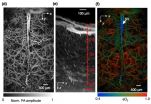(Press-News.org) The medication glyburide, which has been increasingly used to treat gestational diabetes in pregnant women, was associated with higher risk for newborns to be admitted to a neonatal intensive care unit, have respiratory distress, hypoglycemia (low blood glucose), birth injury and be large for gestational age compared with infants born to women treated with insulin, according to an article published online by JAMA Pediatrics.
The prevalence of gestational diabetes mellitus (GDM) in the United States has more than doubled during the last 20 years. Given the widespread and rapid use of glyburide in the last decade more evaluation of the comparative safety and effectiveness of the drug is needed. Previous literature on the association between treatment with glyburide and adverse neonatal outcomes is limited, according to background in the study.
Wendy Camelo Castillo, Ph.D., of the University of Maryland, Baltimore, and Michele Jonsson Funk, Ph.D., of the University of North Carolina at Chapel Hill, and coauthors estimated the risk of adverse maternal and neonatal outcomes in women with GDM treated with glyburide vs. insulin using data from a nationwide employer-based insurance claims database from 2000 through 2011. The authors excluded women with type 1 or 2 diabetes as well as those younger than 15 and older than 45.
Among 110,879 women with GDM, 9,173 women (8.3 percent) were treated with glyburide (4,982 women) or insulin (4,191 women). Use of glyburide rose and the proportion of the group treated with glyburide increased from 8.5 percent in 2000 to 64.4 percent in 2011.
The authors found that among newborns whose mothers were treated with glyburide there was a 41 percent higher risk of neonatal intensive care unit admission, 63 percent higher risk of respiratory distress, 40 percent higher risk of hypoglycemia (low blood glucose), 35 percent higher risk of birth injury and 43 percent higher risk of being large for gestational age compared with newborns of women treated with insulin.
The difference in risk per 100 women associated with glyburide compared with insulin was 2.97 percent for neonatal intensive care unit admission, 1.41 percent for large for gestational age and 1.1 percent for respiratory distress.
Women treated with glyburide, as compared with insulin, were not at increased risk for obstetric trauma, preterm birth or jaundice. The risk of cesarean delivery was 3 percent lower in the glyburide group, according to the results.
"Given the widespread use of glyburide, further investigation of these differences in pregnancy outcomes is a public health priority," the study concludes.
(JAMA Pediatr. Published online March 30, 2015. doi:10.1001/jamapediatrics.2015.74. Available pre-embargo to the media at http://media.jamanetwork.com.)
Editor's Note: Authors made conflict of interest and funding/support disclosures. Please see article for additional information, including other authors, author contributions and affiliations, etc.
Editorial: Glyburide for Gestational Diabetes, Time for a Pause for Thought
In a related editorial, Richard I.G. Holt, Ph.D., F.R.C.P., of the University of Southampton, England, writes: "The major limitation with the current evidence has been the lack of power to demonstrate differences between insulin and glyburide, and this is particularly relevant for rare adverse events. The article by Camelo Castillo et al in this issue of JAMA Pediatrics is therefore a welcome addition to the debate."
"The main limitation of this and other observational analyses is that the results may be affected by important confounding factors. While the authors have adjusted for important medical conditions, they have not adjusted for all relevant sociodemographic features," Holt continues.
"This latest study heightens residual concerns about the use of glyburide to treat GDM that need to be resolved before this drug should be recommended for continued use in pregnancy. As the authors rightly conclude, the "higher risk of neonatal outcomes associated with glyburide-treated women demands further attention" and more attention is needed to determine which women are most likely to benefit from glyburide or perhaps more importantly not be harmed. It is time for a pause for thought," Holt concludes.
(JAMA Pediatr. Published online March 30, 2015. doi:10.1001/jamapediatrics.2015.144. Available pre-embargo to the media at http://media.jamanetwork.com.)
Editor's Note: The author made a conflict of interest disclosure. Please see article for additional information, including other authors, author contributions and affiliations, etc.
INFORMATION:
Media Advisory: To contact author Michele Jonsson Funk, Ph.D., call David Pesci at 919-962-2600 or email dpesci@email.unc.edu. To contact editorial author Richard I.G. Holt, Ph.D., F.R.C.P., email r.i.g.holt@soton.ac.uk.
Turns out, an apple a day won't keep the doctor away but it may mean you will use fewer prescription medications, according to an article published online by JAMA Internal Medicine.
The apple has come to symbolize health and healthy habits. But can apple consumption be associated with reduced health care use because patients who eat them might visit doctors less?
Matthew A. Davis, D.C., M.P.H., Ph.D., of the University of Michigan School of Nursing, Ann Arbor, and coauthors analyzed data from the National Health and Nutrition Examination Survey (2007-2008 and 2009-2010) ...
Scientists have developed tiny 'nanoneedles' that have successfully prompted parts of the body to generate new blood vessels, in a trial in mice.
The researchers, from Imperial College London and Houston Methodist Research Institute in the USA, hope their nanoneedle technique could ultimately help damaged organs and nerves to repair themselves and help transplanted organs to thrive.
The nanoneedles work by delivering nucleic acids to a specific area. Nucleic acids are the building blocks of all living organisms and they encode, transmit and express genetic information. ...
Characterizing associations between socioeconomic factors and children's brain development, a team including investigators from nine universities across the country reports correlative links between family income and brain structure. Relationships between the brain and family income were strongest in the lowest end of the economic range - suggesting that interventional policies aimed at these children may have the largest societal impact. The study, led by researchers at The Saban Research Institute of Children's Hospital Los Angeles and Columbia University Medical Center, ...
A new study has confirmed the existence of a positive feedback operating in climate change whereby warming itself may amplify a rise in greenhouse gases resulting in additional warming.
The study, published in the journal Nature Climate Change, shows that in addition to the well understood effect of greenhouse gases on the Earth's temperature, researchers can now confirm directly from ice-core data that the global temperature has a profound effect on atmospheric greenhouse gas concentrations. This means that as the Earth's temperature rises, the positive feedback in the ...
Hamilton, ON (March 30, 2015) - Researchers from McMaster University and the Icahn School of Medicine at Mount Sinai, New York have discovered that a protein associated with neurodegenerative diseases like ALS also plays an important role in the body's natural antiviral response.
The study, published today in Nature Immunology, offers new insight into the link between neurodegenerative disorders and inflammation, and provides a framework to explore more fully the possibility that viral infection may lead to onset of these diseases.
Matthew Miller, an investigator at ...
There are electrical signals in the nervous system, the brain and throughout the human body and there are tiny magnetic fields associated with these signals that could be important for medical science. Researchers from the Niels Bohr Institute have just developed a method that could be used to obtain extremely precise measurements of ultra-small magnetic fields. The results are published in the scientific journal Nature Physics.
The tiny magnetic fields are all the way down on the atomic level. The atoms do not stand still, they revolve around themselves and the axis is ...
Washington, D.C.-- The 2000-2003 drought in the American southwest triggered a widespread die-off of forests around the region. A Carnegie-led team of scientists developed a new modeling tool to explain how and where trembling aspen forests died as a result of this drought. It is based on damage to the individual trees' ability to transport water under water-stressed conditions.
If the same processes and threshold govern the future, their results suggest that more widespread die-offs of aspen forests triggered by climate change are likely by the 2050s. Tree mortality ...
Researchers studying cancer and other invasive diseases rely on high-resolution imaging to see tumors and other activity deep within the body's tissues. Using a new high-speed, high-resolution imaging method, Lihong Wang, PhD, and his team at Washington University in St. Louis were able to see blood flow, blood oxygenation, oxygen metabolism and other functions inside a living mouse brain at faster rates than ever before.
Using photoacoustic microscopy (PAM), a single-wavelength, pulse-width-based technique developed in his lab, Wang, the Gene K. Beare Professor of Biomedical ...
DENVER - Low pre-surgery uptake of a labeled glucose analogue, a marker of metabolic activity, in the primary tumor of patients with stage I non-small cell lung cancer (NSCLC) is associated with increased overall survival and a longer time before tumor recurrence. Patients with high labeled glucose uptake may benefit from additional therapy following surgery.
Surgery is the standard of care for patients with stage I NSCLC but not all patients are cured, as demonstrated by a 5-year survival rate of less than 60% in these patients. There is a clear need for a diagnostic ...
DETROIT - A "perverse disincentive" for hospitals that have invested in expensive technology for robotic surgery may be jeopardizing prostate cancer patients who seek out the procedure, concluded a new study led by Henry Ford Hospital researchers.
The study, which compared complication rates in hospitals with low volumes of robot-assisted radical prostatectomies (RARPs) to institutions with high volumes of the procedure, suggested that current pay-for-performance healthcare models are to blame.
The new study was published online this month by BJU International.
"Patients ...





